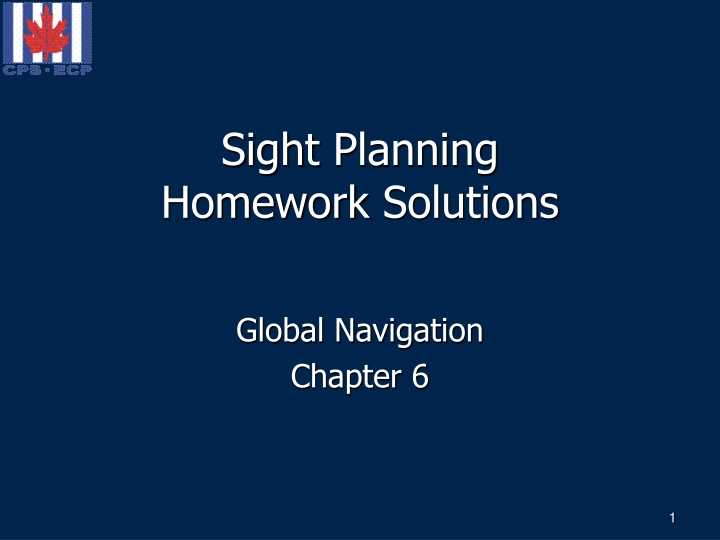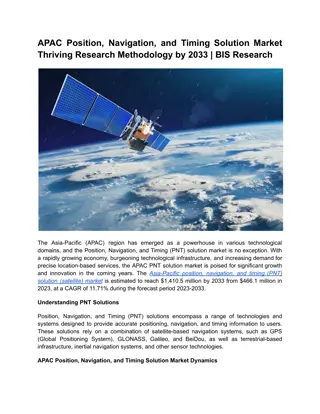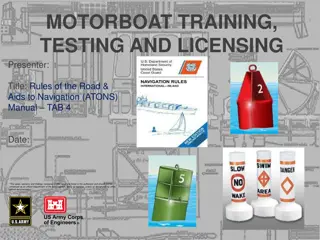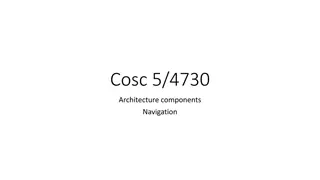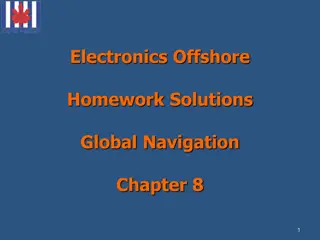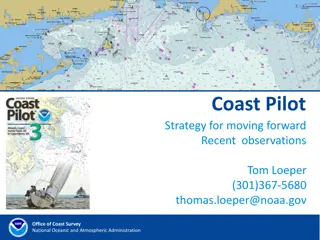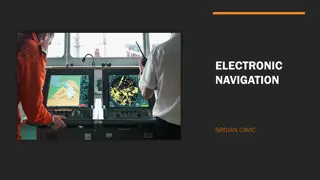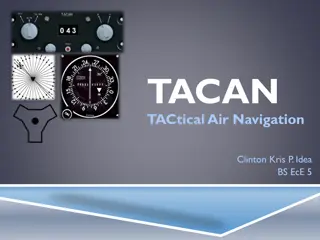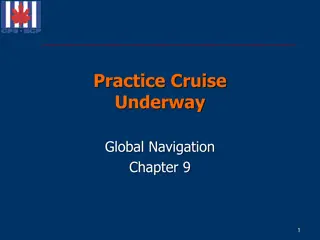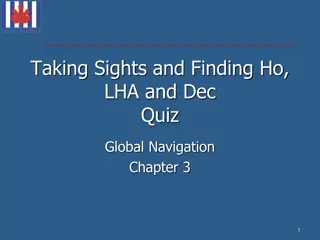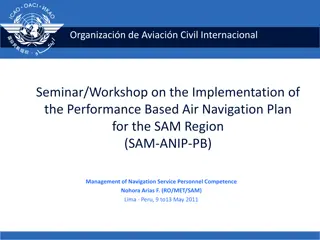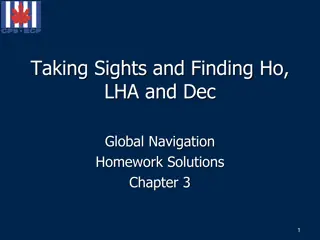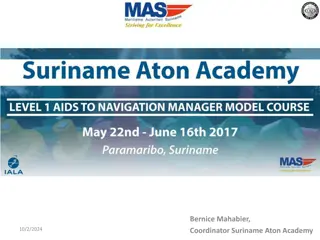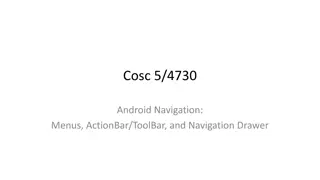Celestial Navigation Chapter 6.1 Homework Solutions
Explore the challenges and solutions to celestial navigation through practical exercises involving star finders, celestial bodies identification, and sight planning tools. Enhance your knowledge of astronomy by setting up tools, locating planets and stars, and mastering the use of templates for plotting celestial bodies.
Download Presentation

Please find below an Image/Link to download the presentation.
The content on the website is provided AS IS for your information and personal use only. It may not be sold, licensed, or shared on other websites without obtaining consent from the author.If you encounter any issues during the download, it is possible that the publisher has removed the file from their server.
You are allowed to download the files provided on this website for personal or commercial use, subject to the condition that they are used lawfully. All files are the property of their respective owners.
The content on the website is provided AS IS for your information and personal use only. It may not be sold, licensed, or shared on other websites without obtaining consent from the author.
E N D
Presentation Transcript
Sight Planning Homework Solutions Global Navigation Chapter 6 1
Objectives Internet resources to identify & locate celestial bodies. Use an electronic sight planning tool, Sight Planner in Celestial Tools . Set up a USPS star finder for any location & time. Set up a USPS star finder for any location & time. 2
Objectives (continued) Select suitable bodies for fixes at twilight or in daytime. Identify an unknown celestial body listed in NA. 3
Pratical Exercise 1 Set up the Star Finder for your present location, at any convenient time on the evening of the day you are reading this. List the planets and first-magnitude stars that will be visible with their azimuths and altitudes to help in locating the bodies. Then go outside and find as many of the listed bodies as you can. 2. Use Celestial Tools to determine the planets and first-magnitude stars that will be visible with their azimuths and altitudes. 4
Question 3 To plot a body on the star finder, set the red template arrow to the value of: a. LHA Aries. b. GHA Aries. c. Right ascension (RA). d. Declination. Ref: 46 5
Question 4 If you rotate the blue template to mimic the passage of time, the arrow will indicate: a. Increasing values of LHA Aries. b. Decreasing values of LHA Aries. c. Increasing values of right ascension. d. Decreasing values of right ascension. Ref: 40 6
Question 5 Right Ascension of the sun is equal to: a. GHA Aries GHA sun. b. 180 - SHA sun. c. 180 + SHA sun. d. SHA sun GHA sun. Ref: 48 7
Question 6 Set your star finder for the northern hemisphere, with the red template in place. Find the solution to a. Then, using the appropriate blue templates and appropriate side of the star base, find the solutions to b, c, and d. a. What is the declination of? Answer : 27 (by inspection). RA = 360 - SHA = 360 -126 16,7 = 233 43,3 (rounded to 234 ) Set 75 N blue template on 234 and read altitude. Altitude is 42 . c. What is its altitude at meridian transit at Latitude 25 S? c. Answer : 38 Solution : Set 25 S blue template on south base d. Answer: Body is below the horizon. d. What is its altitude at meridian transit at Latitude 75 S? b. What is its altitude at meridian transit at Latitude 75 N? Answer: 42 Solution 6b : Calculate RA of Alphecca? at 234 and read altitude. Altitude is 38 d. Solution: Set 75 S blue template on south base at 234 and read altitude. Body is below the horizon. 8
Question 7 a Use the Excerpts from the Nautical Almanac, Appendix B, for the following questions. You are at L35 N, Lo 62 W. It is ZT 2000 on 30 June. a. For this time, plot the planets on the star base and list SHA, RA, dec and magnitude for each. Plot the sun and moon for the same time and list GHA, RA and dec for each. Find LHA Aries? Body GHA RA Dec LHA Magnitude Body 360 -SHA =RA 100 Dec GHA Soleil 179 23 N Venus 360 291 069 18 N -4,4 211 Moon 22 257 26 S Mars 360 234 126 20 N +1,8 152 279 217 23 Jupiter 360 195 165 8 N -1,9 114 Saturn 360 253 Rounded to 107 22 N +0,1 172 217 9
Question 7 b Use the Excerpts from the Nautical Almanac, Appendix B, for the following questions. You are at L35 N, Lo 62 W. It is ZT 2000 on 30 June. b. Choose the bodies for a two-body and three-body twilight fix. Two-body fixes: Vega-Antares, Deneb-Moon, Pollux or Mars-Spica are all reasonable. Three-body fixes: Deneb-Antares-Regulus, Moon-Spica-Regulus. 10
Question 7 c Use the Excerpts from the Nautical Almanac, Appendix B, for the following questions. You are at L35 N, Lo 62 W. It is ZT 2000 on 30 June. c. What is the sun s azimuth at sunset? At sunrise? At sunset, Sun Zn is 298 . At sunrise, Sun Zn is 062 . 11
Question 7 d Use the Excerpts from the Nautical Almanac, Appendix B, for the following questions. You are at L35 N, Lo 62 W. It is ZT 2000 on 30 June. d. Is the approximate altitude of the sun at meridian transit determined by the blue overlay reasonable for a sight? At meridian transit, altitude of the sun is 78 . This is a high altitude sight, so care must be taken to make an accurate observation. 12
Question 7 e Use the Excerpts from the Nautical Almanac, Appendix B, for the following questions. You are at L35 N, Lo 62 W. It is ZT 2000 on 30 June. e. Were the sun and moon available for a 2- body fix earlier in the day on 30 June? No sun-moon fix is possible. The sun is setting as the moon is rising. 13
Question 7 f Use the Excerpts from the Nautical Almanac, Appendix B, for the following questions. You are at L35 N, Lo 62 W. It is ZT 2000 on 30 June. f. From the Almanac, what is the time of meridian transit of Venus on 30 June? Do you expect it to be visible during the daylight? MT is at ZT 1007. It is 2hrs 5 minutes away from MT of the sun and its magnitude is such that it should be visible in the daytime. 14
Question 7 g Use the Excerpts from the Nautical Almanac, Appendix B, for the following questions. You are at L35 N, Lo 62 W. It is ZT 2000 on 30 June. g. Due to cloud cover at twilight, the only bodies available for observation that evening were Antares and a bright body low on the eastern horizon. What is that body? With the 35 N blue template set at evening twilight, the only bright body low in the east is Altair. 15
Question 8-a With a DR position of L35 S, Lo 165 W on 20 March, plan a running fix with an LOP of the sun a short time before transit and a meridian transit LOP. An azimuth cut of 45 between the LOPs should be adequate. The Nautical Almanac indicates that MT will occur at 1207 for your longitude, so plot the sun on your star finder at ZT 1207. Answer the following questions, first using the star finder, then with Celestial Tools (when using Celestial Tools, use the date 20 Mar 2004). a. What is the azimuth of the sun at transit and LHA Aries when the sun is at transit? Using the Star Finder: Zn = 000 , LHA Aries= 001 (By inspection) Using Celestial tool: Zn = 360 , LHA Aries = 001 16
Question 8-b With a DR position of L35 S, Lo 165 W on 20 March, plan a running fix with an LOP of the sun a short time before transit and a meridian transit LOP. An azimuth cut of 45 between the LOPs should be adequate. The Nautical Almanac indicates that MT will occur at 1207 for your longitude, so plot the sun on your star finder at ZT 1207. Answer the following questions, first using the star finder, then with Celestial Tools (when using Celestial Tools, use the date 20 Mar 2004). When the azimuth of the sun is 045 , what is the LHA of Aries? Star Finder : 332 Celestial tool : 331 Solution : Zn 045 occurs from 1004 to 1010. Using midpoint 1007, LHA Aries = 331 17
Question 8 c With a DR position of L35 S, Lo 165 W on 20 March, plan a running fix with an LOP of the sun a short time before transit and a meridian transit LOP. An azimuth cut of 45 between the LOPs should be adequate. The Nautical Almanac indicates that MT will occur at 1207 for your longitude, so plot the sun on your star finder at ZT 1207. Answer the following questions, first using the star finder, then with Celestial Tools (when using Celestial Tools, use the date 20 Mar 2004). What is the difference between this LHA Aries and the LHA of Aries at LAN? Star Finder: 29 Celestial tool: 30 . Solution : (360 -331 ) + 001 = 30 18
Question 8 d With a DR position of L35 S, Lo 165 W on 20 March, plan a running fix with an LOP of the sun a short time before transit and a meridian transit LOP. An azimuth cut of 45 between the LOPs should be adequate. The Nautical Almanac indicates that MT will occur at 1207 for your longitude, so plot the sun on your star finder at ZT 1207. Answer the following questions, first using the star finder, then with Celestial Tools (when using Celestial Tools, use the date 20 Mar 2004). What is the LHA difference, converted to time? Star Finder : 1 hour 56 minutes. Solution : 29 X 4m/degree= 116 minutes/60 = 1 hour 56 minutes. Celestial tool: 2 hours. Solution : 30 X 4min/degree = 120 min/60 = 2 hours 19
Question 8 e With a DR position of L35 S, Lo 165 W on 20 March, plan a running fix with an LOP of the sun a short time before transit and a meridian transit LOP. An azimuth cut of 45 between the LOPs should be adequate. The Nautical Almanac indicates that MT will occur at 1207 for your longitude, so plot the sun on your star finder at ZT 1207. Answer the following questions, first using the star finder, then with Celestial Tools (when using Celestial Tools, use the date 20 Mar 2004). With transit occurring at 1207, when should you take the earlier sight? Star Finder : 1011. Solution 1207 0156 = 1011 Celestial tool: 1007. Solution : 1207 2 hours = 1007 (Zn = 045 ) 20
Question 8 f After meridian passage, you can do the same thing to obtain another running fix. At what time should you take the afternoon sight? With a DR position of L35 S, Lo 165 W on 20 March, plan a running fix with an LOP of the sun a short time before transit and a meridian transit LOP. An azimuth cut of 45 between the LOPs should be adequate. The Nautical Almanac indicates that MT will occur at 1207 for your longitude, so plot the sun on your star finder at ZT 1207. Answer the following questions, first using the star finder, then with Celestial Tools (when using Celestial Tools, use the date 20 Mar 2004). Star Finder: 1403. Solution : 1207 + 0156 = 1403 Celestial tool: 1407. Solution : 1207 + 2 hours = 1407 (Zn = 315) 21
Sight Planning End of Global Navigation Chapter 6 22
